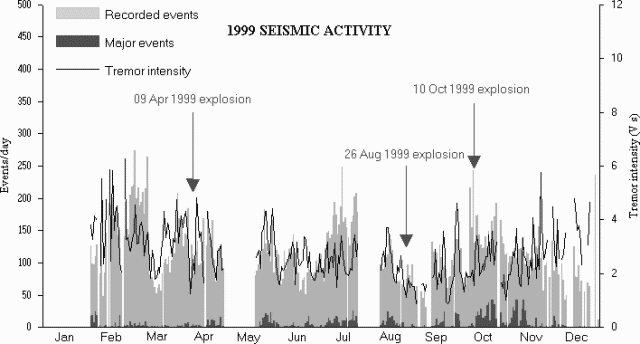Report on Stromboli (Italy) — January 2000
Bulletin of the Global Volcanism Network, vol. 25, no. 1 (January 2000)
Managing Editor: Richard Wunderman.
Stromboli (Italy) 1999 seismic summary and some stronger-than-usual eruptions
Please cite this report as:
Global Volcanism Program, 2000. Report on Stromboli (Italy) (Wunderman, R., ed.). Bulletin of the Global Volcanism Network, 25:1. Smithsonian Institution. https://doi.org/10.5479/si.GVP.BGVN200001-211040
Stromboli
Italy
38.789°N, 15.213°E; summit elev. 924 m
All times are local (unless otherwise noted)
Reports of a strong eruption on the morning of 26 August were submitted to Stromboli On-line (maintained by Jürg Alean and Roberto Carniel) by a variety of sources, including Gianfranco Cincotta, Franco Iacop, Danielle Cottens, Klaus Jäger, and others. Another strong eruption was noted on 10 October. Throughout 1999 activity apparently continued at low levels, with between 50 and 250 daily seismic events registered at the summit (figure 60).
The first report of the 26 August explosion came from Gianfranco Cincotta, who reported that a normal explosion from Crater 3 at 0058 was followed by a more intense one at Crater 1. Then, after a tremor, the large explosion came from the vent in front of Crater 2, which is considered part of Crater 3 for "historical" reasons but has almost reached the status of an independent crater. The event happened as the evening tourist group descended the volcano and the night group was still climbing. Pyroclastic material was clearly visible from the village and fell over a wide area, including the path section with the observation points around the 700-m level. Fortunately this time few pyroclasts reached the reed vegetation on the upper slopes. Nevertheless, Danielle Cottens saw some small fires from Scari. According to Cincotta, 10 tourists asked for medical assistance. All were slightly injured, mostly because of the sudden run from the craters. A man inside his sleeping bag on the Pizzo was slightly burned by pyroclasts.
Henrik Berger also reported via Stromboli On-line that he and friends were camping on the Pizzo the night of 25-26 August; there were a total of seven people on the summit. A normal eruption of Crater 3 produced the usual amount of ash and little glowing lava. Perhaps one minute later, at about 0057, a significant tremor occurred, immediately followed by an eruption at Crater 1. Less than one second afterwards the small incandescent middle vent exploded with a bang. Lava shot from this vent to about twice the usual height. Most pyroclasts were ejected by Crater 1. The group fled in panic as incandescent volcanic bombs up to 30 x 50 cm impacted nearby. A lot of non-glowing material was also ejected. One woman's hand was hit by a glowing piece of scoria. A girl who had been sleeping barefoot in her sleeping bag suffered minor burns on her feet and hands. On the other side of Pizzo another person suffered burns on his belly.
On 15 September Boris Behncke was at the summit and found numerous scoriaceous bombs on and around the Pizzo sopra la Fossa that had flattened upon impact; many had diameters of 20 cm or more. In one case, a bomb had fallen on the rim of one of the primitive shelters made by tourists in the summit area. Eruptive activity was at relatively low levels, and observations into Crater 3 were made for about 10 minutes. The crater floor was covered with a mixture of previously ejected scoriae and partially altered blocks fallen off the crater walls. Explosions pierced this mixture in at least two locations, and incandescent scoriae sprayed 15-20 m above the crater floor, which lay about 30 m below observation points on the S crater rim. During three hours of observation explosions occurred from up to three vents in Craters 1 and 3, and a persistent fluctuating glow was visible after nightfall in the northernmost part of Crater 1. This glow had been visible to Behncke previously during August while passing Stromboli island twice on the ferry connecting the Aeolian Islands with Naples.
Danielle Cottens reported via Stromboli On-line that while she was on the Pizzo around 1830 on 10 October the volcano was showing intense activity, with bombs often reaching the base of the Pizzo. Around 1930 she decided to go back to the village. After 30 minutes, at about 2000, a significant explosion occurred that ejected ash and scoria onto Pizzo and in the Fossetta. Other tourist groups climbing the volcano decided to go back.
Geological Summary. Spectacular incandescent nighttime explosions at Stromboli have long attracted visitors to the "Lighthouse of the Mediterranean" in the NE Aeolian Islands. This volcano has lent its name to the frequent mild explosive activity that has characterized its eruptions throughout much of historical time. The small island is the emergent summit of a volcano that grew in two main eruptive cycles, the last of which formed the western portion of the island. The Neostromboli eruptive period took place between about 13,000 and 5,000 years ago. The active summit vents are located at the head of the Sciara del Fuoco, a prominent scarp that formed about 5,000 years ago due to a series of slope failures which extends to below sea level. The modern volcano has been constructed within this scarp, which funnels pyroclastic ejecta and lava flows to the NW. Essentially continuous mild Strombolian explosions, sometimes accompanied by lava flows, have been recorded for more than a millennium.
Information Contacts: Stromboli On-line, maintained by Jürg Alean and Roberto Carniel (URL: http://www.swisseduc.ch/stromboli/); Roberto Carniel, Dipartimento di Georisorse e Territorio, Universitá di Udine, Via Cotonificio, 114 I33100 Udine; Jürg Alean, Kantonsschule Zürcher Unterland, CH8180 Bülach, Switzerland; Boris Behncke, Dipartimento di Scienze Geologiche, Palazzo delle Scienze, Università di Catania (DSGUC), Corso Italia 55, 95129 Catania, Italy.


